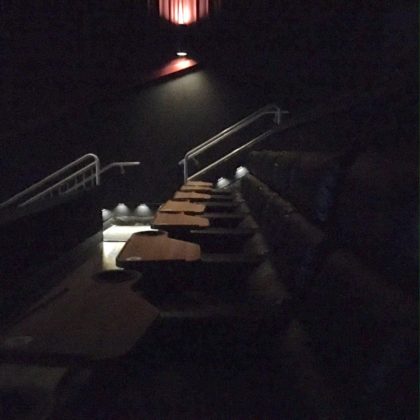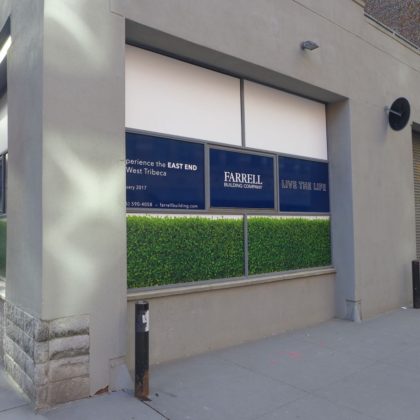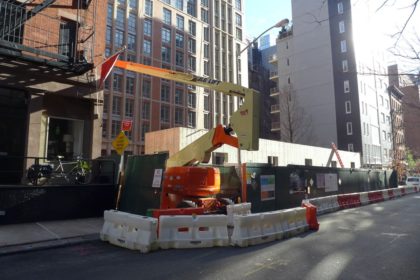Categories
Left column house ads
Seen & Heard: A Dissenting Opinion on Pier 26
December 21, 2016 Community News, Real Estate, Services
••• I finally made it to the revamped Regal Battery Park cineplex. (La La Land! Loved it, and there were only a dozen of us at the 12:15 p.m. screening.) The new seats are a big improvement, with a ton of leg room, although I felt a bit tall for them, and I wish the tray could be stowed away somehow. (Mine did not look like this.) The Premium Plus seats at the new iPic in the Seaport are far more comfortable, but they’re also more expensive. As I mentioned before, the best innovation at both establishments might be the reservable seats, because you can arrive 10 minutes past showtime without fear of being relegated to Siberia. (Trust me—you really want to miss the preview for the movie about dog reincarnation.) As a result of my late arrival, however, the theater was already dark, making for a poor photo.
 ••• You have permission to leave this post, briefly, to take the five-question Best of New Tribeca survey. You’ll need all of three minutes.
••• You have permission to leave this post, briefly, to take the five-question Best of New Tribeca survey. You’ll need all of three minutes.
••• Confused by the signage at 11 Hubert, I called Farrell Building. The company is opening a showroom for a bunch of Hamptons properties, possibly as soon as January 12, so you can experience the craftsmanship without having to schlep yourself out east. And then in a year or so, the building will be torn down to make way for this single-family home.
 ••• I quote like the design for 261 Hudson, the Related rental building nearing completion above Canal. But I was hoping the Renwick side would be open space, when it now appears that a low-slung structure of some kind will block the open space from view.
••• I quote like the design for 261 Hudson, the Related rental building nearing completion above Canal. But I was hoping the Renwick side would be open space, when it now appears that a low-slung structure of some kind will block the open space from view.
 ••• Stephen Korns wrote a thoughtful dissent about the plan for Pier 26.
••• Stephen Korns wrote a thoughtful dissent about the plan for Pier 26.
I find his to be a sad design that could be an equal-sized park somewhere on land. Its “forest”, play space, “dune” grassland, etc., avoid engaging the living, changing river in a meaningful way. Despite the inclusion of an ambitious pier-end steel mesh “lounge”, the overall design focuses on a program of uses and urban park conventions, rather than this unique “place”. Aside from its existing views of the sky and river-sweep, most of it could be located within the buildings of Battery Park City, or in Philadelphia.
What is this place?
This river is alive. It is an immense complex of tidal, seasonal, and weather-related events—and human activity—that profoundly influence the water and the creatures that live in it. It is based on water-born plants and animals that sustain all life on earth. The nature of the Estuary is as fascinating and profound—and hidden—as any place in nature.
Mere blocks from the World Trade Center and its diverse memorials, Pier 26 can offer an intimate encounter with the intelligence in nature if we provide a means to observe it. It can help remedy our increasingly over-designed City and our collective need for greater ecological awareness in a time of rapid species depletion and perilous climate change. These are needs that will only increase in the years ahead.
The Estuarium should be the focus of Pier 26 and should be located upon it and well offshore, with ample deck and dockside space to enable the netting, collecting and study, dive support and small boat use, water sampling and other research activities that are part of an exciting marine research and education program that engages the public. The Clearwater should be part of this program.
Think Woods Hole.
To reveal the intense life and ecology of this place, river water should be pumped up to deck-level to flow through aquarium tanks that display river creatures and how they interact with one another and with the brackish tidal water that changes day to day and hour to hour.
The River Project pioneered this Estuarium concept on Pier 26 in 1986 on a shoestring budget, and helped to establish the Hudson River Park Estuarine Sanctuary that now extends to 59th Street. There is no other program in New York or in the world that offers such an intimate and in-depth experience of the living environment in such close proximity to its urban setting.
Olin’s concept design locates the Estuarium in a box next to a noisy highway and a fantasy playground that offer little contact with the water. Their pier and pathway offer a series of encounters with artificial landscape zones that are largely a repeat of the adjacent Pier 25.
None of these experiences provide a view of the life beneath the water’s surface, nor any insights about what is hidden in this place. Why limit our vision to a conventional list of park amenities on Pier 26 that repeats what is available nearby in the Park and ignores the potential to connect with the gigantic living space that surrounds it?
Out on the pier’s end, surrounded by water, it may be that walking or sitting on an open-mesh surface 10-15 feet above the water will provide a physical thrill and a memorable encounter with the water’s surface action. Given this river’s nature, this may rarely be restful or likely to invite a person to linger. Visitors can already observe this on the open meshes of the East River Park at Wall Street.
A restless tendency may be especially true above an artificial wetland, if we are to imagine the oyster shoals, insects, floating trash and periodic effluents that are natural to this location.
I hope that all the designers and stakeholders that are involved in this worthy project will recognize that Pier 26 represents an opportunity for the public to encounter the living river above and below the water’s surface and a legacy for future generations that we cannot squander on a conventional menu of urban park amenities. There will never again be such an opportunity to access the life in this location which is so important to New York City and the world.
Comment:
Subscribe
Subscribe to the TC Newsletter













